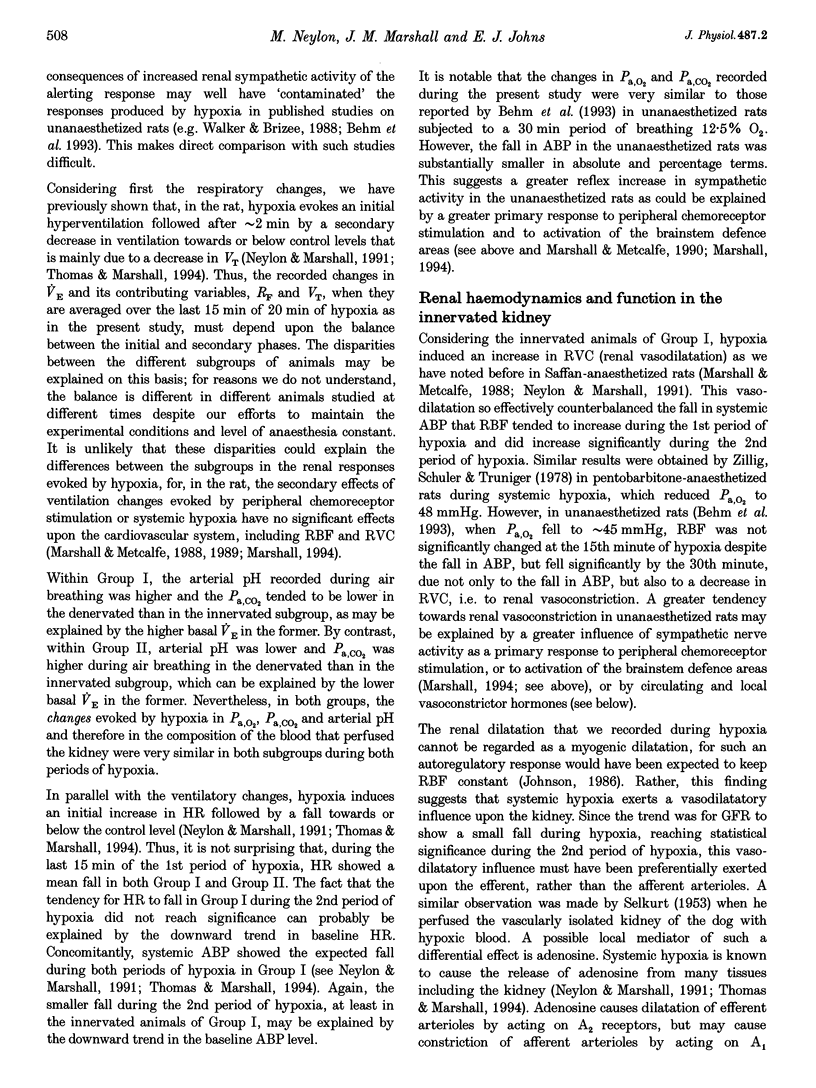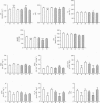Abstract
1. In rats anaesthetized with Saffan, renal function was monitored from the left kidney from the 5th minute of spontaneous breathing of 12% O2 for two 20 min periods and during air breathing before, between and after the hypoxic periods. Two groups of animals (I and II) were used, each group comprising two subgroups in which the left kidney was innervated or denervated, respectively; in Group II, renal perfusion pressure (RPP) was maintained during the 2nd hypoxic period by occl97uding the distal aorta. 2. In both subgroups of Group I, both hypoxic periods produced hyperventilation, arterial PO2 falling to approximately 50 mmHg. Concomitantly, mean arterial pressure (MABP) fell by similar extents (approximately 23%, from a baseline level of 140 mmHg during the 2nd hypoxic period). In the innervated subgroup, renal vascular conductance (RVC) increased, but glomerular filtration rate (GFR) fell (by 48 and 6%, respectively, during the 2nd hypoxic period), while urine flow, absolute sodium excretion (UNaV) and fractional sodium excretion (FENa) fell (by 52, 63 and 61%, respectively). Baseline urine flow, UNaV and FENa were higher in the denervated subgroup, but hypoxia produced similar percentage changes from baseline in all variables. 3. In Group II, both subgroups showed similar changes during the 1st hypoxic period as the corresponding subgroups of Group I. However, during the 2nd hypoxic period when the fall in MABP was reduced to approximately 7%, the increase in RVC persisted only in the denervated subgroup; there was no significant change in GFR, urine flow, UNaV or FENa in either subgroup. 4. These results indicate that, in the rat, moderate hypoxia produces antidiuresis and antinatriuresis that are not dependent on the renal nerves, but are dependent on the hypoxia-induced fall in MABP. The fall in renal perfusion pressure (RPP) may directly determine renal function, but reflex influences upon the kidney initiated by, for example, arterial baroreceptor unloading, may play a role. The fall in GFR and increase in RVC, which persisted after denervation or when renal perfusion was controlled, implies a local dilatatory influence acting preferentially on the efferent arterioles.
Full text
PDF














Images in this article
Selected References
These references are in PubMed. This may not be the complete list of references from this article.
- Anderson R. J., Pluss R. G., Berns A. S., Jackson J. T., Arnold P. E., Schrier R. W., McDonald K. E. Mechanism of effect of hypoxia on renal water excretion. J Clin Invest. 1978 Oct;62(4):769–777. doi: 10.1172/JCI109188. [DOI] [PMC free article] [PubMed] [Google Scholar]
- Anderson R. J., Pluss R. G., Pluss W. T., Bell J., Zerbe G. G. Effect of hypoxia and hypercapnic acidosis on renal autoregulation in the dog: role of renal nerves. Clin Sci (Lond) 1983 Nov;65(5):533–538. doi: 10.1042/cs0650533. [DOI] [PubMed] [Google Scholar]
- Behm R., Mewes H., DeMuinck Keizer W. H., Unger T., Rettig R. Cardiovascular and renal effects of hypoxia in conscious carotid body-denervated rats. J Appl Physiol (1985) 1993 Jun;74(6):2795–2800. doi: 10.1152/jappl.1993.74.6.2795. [DOI] [PubMed] [Google Scholar]
- Bruns F. J. Decrease in renal perfusion, glomerular filtration and sodium excretion by hypoxia in the dog. Proc Soc Exp Biol Med. 1978 Dec;159(3):468–472. doi: 10.3181/00379727-159-40372. [DOI] [PubMed] [Google Scholar]
- Colice G., Yen S., Ramirez G., Dietz J., Ou L. C. Acute hypoxia-induced diuresis in rats. Aviat Space Environ Med. 1991 Jun;62(6):551–554. [PubMed] [Google Scholar]
- Cowley A. W., Jr, Roman R. J., Krieger J. E. Pathways linking renal excretion and arterial pressure with vascular structure and function. Clin Exp Pharmacol Physiol. 1991 Jan;18(1):21–27. doi: 10.1111/j.1440-1681.1991.tb01371.x. [DOI] [PubMed] [Google Scholar]
- Firth J. D., Raine A. E., Ledingham J. G. The mechanism of pressure natriuresis. J Hypertens. 1990 Feb;8(2):97–103. doi: 10.1097/00004872-199002000-00001. [DOI] [PubMed] [Google Scholar]
- Forsling M. L., Aziz L. A. Release of vasopressin in response to hypoxia and the effect of aminergic and opioid antagonists. J Endocrinol. 1983 Oct;99(1):77–86. doi: 10.1677/joe.0.0990077. [DOI] [PubMed] [Google Scholar]
- Fukuda Y., Sato A., Suzuki A., Trzebski A. Autonomic nerve and cardiovascular responses to changing blood oxygen and carbon dioxide levels in the rat. J Auton Nerv Syst. 1989 Oct;28(1):61–74. doi: 10.1016/0165-1838(89)90008-8. [DOI] [PubMed] [Google Scholar]
- Honig A. Peripheral arterial chemoreceptors and reflex control of sodium and water homeostasis. Am J Physiol. 1989 Dec;257(6 Pt 2):R1282–R1302. doi: 10.1152/ajpregu.1989.257.6.R1282. [DOI] [PubMed] [Google Scholar]
- Johns E. J., Lewis B. A., Singer B. The sodium-retaining effect of renal nerve activity in the cat: role of angiotensin formation. Clin Sci Mol Med. 1976 Jul;51(1):93–102. doi: 10.1042/cs0510093. [DOI] [PubMed] [Google Scholar]
- Johns E. J. Role of angiotensin II and the sympathetic nervous system in the control of renal function. J Hypertens. 1989 Sep;7(9):695–701. [PubMed] [Google Scholar]
- Johnson P. C. Autoregulation of blood flow. Circ Res. 1986 Nov;59(5):483–495. doi: 10.1161/01.res.59.5.483. [DOI] [PubMed] [Google Scholar]
- Karim F., Poucher S. M., Summerill R. A. The effects of stimulating carotid chemoreceptors on renal haemodynamics and function in dogs. J Physiol. 1987 Nov;392:451–462. doi: 10.1113/jphysiol.1987.sp016790. [DOI] [PMC free article] [PubMed] [Google Scholar]
- Koller E. A., Bührer A., Felder L., Schopen M., Vallotton M. B. Altitude diuresis: endocrine and renal responses to acute hypoxia of acclimatized and non-acclimatized subjects. Eur J Appl Physiol Occup Physiol. 1991;62(3):228–234. doi: 10.1007/BF00643747. [DOI] [PubMed] [Google Scholar]
- Louwerse A. M., Marshall J. M. The role of vasopressin in the regional vascular responses evoked in the spontaneously breathing rat by systemic hypoxia. J Physiol. 1993 Oct;470:463–472. doi: 10.1113/jphysiol.1993.sp019869. [DOI] [PMC free article] [PubMed] [Google Scholar]
- Marshall J. M. Analysis of cardiovascular responses evoked following changes in peripheral chemoreceptor activity in the rat. J Physiol. 1987 Dec;394:393–414. doi: 10.1113/jphysiol.1987.sp016877. [DOI] [PMC free article] [PubMed] [Google Scholar]
- Marshall J. M., Metcalfe J. D. Analysis of the cardiovascular changes induced in the rat by graded levels of systemic hypoxia. J Physiol. 1988 Dec;407:385–403. doi: 10.1113/jphysiol.1988.sp017422. [DOI] [PMC free article] [PubMed] [Google Scholar]
- Marshall J. M., Metcalfe J. D. Effects of systemic hypoxia on the distribution of cardiac output in the rat. J Physiol. 1990 Jul;426:335–353. doi: 10.1113/jphysiol.1990.sp018141. [DOI] [PMC free article] [PubMed] [Google Scholar]
- Marshall J. M., Metcalfe J. D. Influences on the cardiovascular response to graded levels of systemic hypoxia of the accompanying hypocapnia in the rat. J Physiol. 1989 Mar;410:381–394. doi: 10.1113/jphysiol.1989.sp017539. [DOI] [PMC free article] [PubMed] [Google Scholar]
- Marshall J. M. Peripheral chemoreceptors and cardiovascular regulation. Physiol Rev. 1994 Jul;74(3):543–594. doi: 10.1152/physrev.1994.74.3.543. [DOI] [PubMed] [Google Scholar]
- Nakamura K. T., Ayres N. A., Gomez R. A., Robillard J. E. Renal responses to hypoxemia during renin-angiotensin system inhibition in fetal lambs. Am J Physiol. 1985 Jul;249(1 Pt 2):R116–R124. doi: 10.1152/ajpregu.1985.249.1.R116. [DOI] [PubMed] [Google Scholar]
- Neylon M., Marshall J. M. The role of adenosine in the respiratory and cardiovascular response to systemic hypoxia in the rat. J Physiol. 1991;440:529–545. doi: 10.1113/jphysiol.1991.sp018723. [DOI] [PMC free article] [PubMed] [Google Scholar]
- Rose C. E., Jr, Althaus J. A., Kaiser D. L., Miller E. D., Carey R. M. Acute hypoxemia and hypercapnia: increase in plasma catecholamines in conscious dogs. Am J Physiol. 1983 Dec;245(6):H924–H929. doi: 10.1152/ajpheart.1983.245.6.H924. [DOI] [PubMed] [Google Scholar]
- SELKURT E. E. Influence of hypoxia on renal circulation and on excretion of electrolytes and water. Am J Physiol. 1953 Mar;172(3):700–708. doi: 10.1152/ajplegacy.1953.172.3.700. [DOI] [PubMed] [Google Scholar]
- Spielman W. S., Thompson C. I. A proposed role for adenosine in the regulation of renal hemodynamics and renin release. Am J Physiol. 1982 May;242(5):F423–F435. doi: 10.1152/ajprenal.1982.242.5.F423. [DOI] [PubMed] [Google Scholar]
- Thomas T., Marshall J. M. Interdependence of respiratory and cardiovascular changes induced by systemic hypoxia in the rat: the roles of adenosine. J Physiol. 1994 Nov 1;480(Pt 3):627–636. doi: 10.1113/jphysiol.1994.sp020389. [DOI] [PMC free article] [PubMed] [Google Scholar]
- ULLMANN E. Acute anoxia and the excretion of water and electrolyte. J Physiol. 1961 Mar;155:417–437. doi: 10.1113/jphysiol.1961.sp006637. [DOI] [PMC free article] [PubMed] [Google Scholar]
- Walker B. R., Brizzee B. L. Renal vascular response to combined hypoxia and hypercapnia in conscious rats. Am J Physiol. 1988 Mar;254(3 Pt 2):R552–R558. doi: 10.1152/ajpregu.1988.254.3.R552. [DOI] [PubMed] [Google Scholar]
- Walker B. R. Diuretic response to acute hypoxia in the conscious dog. Am J Physiol. 1982 Nov;243(5):F440–F446. doi: 10.1152/ajprenal.1982.243.5.F440. [DOI] [PubMed] [Google Scholar]
- Zillig B., Schuler G., Truniger B. Renal function and intrarenal hemodynamics in acutely hypoxic and hypercapnic rats. Kidney Int. 1978 Jul;14(1):58–67. doi: 10.1038/ki.1978.89. [DOI] [PubMed] [Google Scholar]




